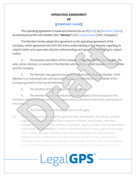How to Write a Sales Representative Agreement: Step-by-Step Guide
Starting a journey as an entrepreneur, there comes a moment when you need to expand your sales team or engage with independent sales representatives....
6 min read
LegalGPS : Oct. 8, 2024
When running a business, it’s important to make sure all your legal bases are covered. One key area often overlooked is understanding the role and importance of a retailer agreement. In this blog post, we’ll demystify retailer agreements for you, offering clear and comprehensible information about what they are, why you need them, and how they can protect your business.


Retailer Agreement
Access our Retailer Agreement Template to formalize partnerships with retailers. Ensure clear terms and mutual understanding.
Trusted by 1,000+ businesses to safeguard their LLCs.
A retailer agreement is a contract between a supplier or manufacturer and a business that agrees to sell or distribute the supplier's products. It outlines the terms and conditions of this relationship, ensuring that both parties understand their rights, duties, terms of payment, and many other essential details.
Such an agreement provides a framework within which business can function seamlessly, and can safeguard against potential disputes down the line. It clarifies the expectations of both parties, making it an invaluable tool for your business arsenal.
Retailer agreements vary based on the product, market, and specific arrangements between the parties involved. However, there are a few key components that are typically included in most retailer agreements:
Parties Involved: This section identifies the legal names of the supplier or manufacturer and the retailer.
Terms & Conditions: Here, the duration of the agreement, nature of the relationship, price points, sales targets, and other pertinent details are outlined.
Obligations & Responsibilities: This part clearly articulates what each party is responsible for. This can include marketing efforts, inventory levels, returns policy, and more.
Territory: This section outlines the geographic boundaries in which each party is free to operate. If there are any exceptions to this, they should be clearly outlined here.
Marketing Support: Both parties agree on how much support will be provided by each other when it comes to marketing efforts. This can include social media posts, blog content, and more.
Distribution: This section outlines how products will be distributed from one party to the other. For example, if you’re an influencer who wants to sell a product on your social media platforms, it should be clear how many units will be sent out and when.
Pricing & Discounts: How much does it cost for each party to purchase items? And what discounts are available in case they want more than usual?
How to Draft a Contract For Buying Goods
A well-drafted retailer agreement serves to protect the interests of both parties involved. Here’s how:
Protect Interests: By clearly outlining the terms of the business relationship, a retailer agreement can safeguard your business from potential disputes.
Avoid Miscommunication: A retailer agreement leaves little room for ambiguity or miscommunication. This can result in a smoother, more harmonious business relationship.
Legal Compliance: By adhering to a professionally drafted retailer agreement, you are more likely to stay in line with relevant laws and industry regulations.
Reduce Risk: By outlining the responsibilities and obligations of each party, a retailer agreement can help reduce the risk of costly disputes.
Protect Intellectual Property: By ensuring that your brand is not being used without permission, a retailer agreement helps to protect your intellectual property rights.
Retain Control: By laying out the terms of your agreement, you can retain control over the relationship and avoid feeling like a victim.
Set Expectations: A retailer agreement helps to set expectations for both parties. This can help prevent future misunderstandings or disagreements from arising.


Legal GPS Pro
Protect your business with our complete legal subscription service, designed by top startup attorneys.
Creating a retailer agreement doesn't have to be complicated. Here's a breakdown of the process to ensure you have a thorough, legally binding document ready for your business needs.
Identification of Parties: Begin by clearly identifying the legal names, addresses, and contact information for both the supplier (or manufacturer) and the retailer. This sets the foundation for the agreement, ensuring you know exactly who is involved in the contractual relationship.
Recitals: A recital section provides background information on the purpose of the agreement. You can mention what prompted the parties to make the agreement and confirm their understanding of the goals of the business relationship.
Parties to the Agreement: Next, identify what parties are involved in the agreement. This may include any additional partners or third parties that may be involved in the relationship, such as a manufacturer's representative or partner company. If a supplier is signing on behalf of their company, specify that this is done so as an agent for their corporate entity.
Terms and Conditions: Outline the primary terms governing the relationship. Be specific and thorough, covering aspects such as:
Duration: Define the start and end dates of the agreement or if it's ongoing until terminated by either party.
Territory: Establish the geographical area where the retailer is allowed to sell the products.
Pricing: Detail the pricing model, discounts, or rebates available to the retailer.
Exclusivity: Specify if the agreement is exclusive, meaning the supplier won't sell to other retailers in the outlined territory.
Obligations and Responsibilities: Clearly state the obligations and responsibilities of both parties, covering aspects such as:
Supply and Inventory: Define the terms for product supply, including delivery timelines, minimum order quantities, and inventory management.
Marketing and Sales: Establish responsibilities for marketing and growing sales, including goals, budgets, and any cooperative advertising efforts.
Training and Support: Detail any training, support, or resources the supplier will provide to the retailer.
Quality Assurance: Address any product quality requirements and standards, and clarify how the retailer should handle returns or warranties.
Intellectual Property: Explain the permissible use of branding, trademarks, copyrights, or other intellectual property belonging to the supplier.
Payment Terms: State the payment terms, specifying invoicing procedures, payment schedules, and any consequences for late or non-payment.
Termination and Amendments: Clearly define the terms under which either party may terminate the agreement. Make sure to cover notice periods, grounds for termination, and any potential penalties. Specify how the agreement can be amended, ensuring both parties mutually consent to any changes.
Dispute Resolution: Detail how potential disputes will be resolved. Designate the preferred method, whether it be mediation, arbitration, or litigation, and specify any applicable governing law or jurisdictional venue.
Additional Clauses: Depending on the specifics of your business relationship, you may need to insert additional clauses, such as:
Confidentiality: Include terms that address how sensitive information should be treated and the obligations of the parties to protect such information.
Indemnification: Establish the expectation that each party will indemnify and hold harmless the other against certain types of losses or damages.
Signatures: Have both parties sign and date the agreement to make it legally binding. It is recommended that you and the other party each have your own attorney review the agreement before signing.
By following these steps, you can draft a retailer agreement that clearly outlines the responsibilities and expectations for both the supplier and the retailer. Remember, your retailer agreement should be tailored to your specific business needs, so always seek legal advice to ensure it's comprehensive and legally compliant.
Keep in mind, this is a foundational guide and other specific clauses may be necessary. Legal advice should be sought for personalized guidance.
Get Your Retailer Agreement Template
with a Legal GPS Subscription
While creating a retailer agreement, be cautious not to make common mistakes that can put your business at risk:
Being Vague: Be as specific as possible in your agreement to prevent potential disputes or misunderstanding. Clarify all responsibilities, commitments, and obligations clearly.
Ignoring Legal Advice: While templates and guides can be very helpful, it's also crucial to seek legal advice to ensure that your agreement is legally sound and best serves your business's interest.
Failing to Address all Potential Situations: Make sure the agreement includes provisions for what will happen during a business disruption or disagreement.
Understanding, and subsequently drafting a strong retailer agreement can be complex, but it is an integral component of any healthy business relationship. It’s here that we can help. Legal GPS provides intuitive, easy-to-use retail agreement templates to help your business thrive.
Providing clarity and accountability, our retailer agreement templates offer peace of mind and personalized solutions for your business's success. From setting out obligations to clear labeling of the parties involved, our templates are designed to make the complex simple, and the difficult manageable. Take control of your business's future today. Get started with our retailer agreement templates – informing, supporting, and growing your business is our priority.

Retailer Agreement
Access our Retailer Agreement Template to formalize partnerships with retailers. Ensure clear terms and mutual understanding.
Trusted by 1,000+ businesses to safeguard their LLCs.
The biggest question now is, "Do I need a business lawyer?” For most businesses and in most cases, you don't need a lawyer to start your business. Instead, many business owners rely on Legal GPS Pro to help with legal issues.
Legal GPS Pro is your All-In-One Legal Toolkit for Businesses. Developed by top startup attorneys, Pro gives you access to 100+ expertly crafted templates including operating agreements, NDAs, and service agreements, and an interactive platform. All designed to protect your company and set it up for lasting success.
Get Legal GPS's Retailer Agreement Template Now

Legal GPS Pro
Protect your business with our complete legal subscription service, designed by top startup attorneys.
|
Premium Template
Single-use Template |
Legal GPS Pro
Unlimited Access, Best Value |
|
|
| Choose Template | Learn More |
| Trusted by 1000+ businesses | |

Starting a journey as an entrepreneur, there comes a moment when you need to expand your sales team or engage with independent sales representatives....

When it comes to buying and selling goods or property, having the right legal documentation in place is essential. One such document is the bill of...

As an entrepreneur, getting all the legalities correct is vital to protect your interests and ensure your business runs smoothly. One such legal...